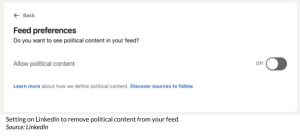How to Avoid Information Bias During the Mid-terms
Rush Ashford | October 14, 2022
Not all social media platforms promote and police political information equally. Understand the steps you can take as a user of these platforms to limit your political information bias.
Social media platforms played a significant role in the outcome of recent elections1. Over 90%2 of Americans actively use social media platforms, making them an increasingly relied-upon outlet for politicians, activists, and companies to campaign, distribute information and engage with voters. Social media platforms are not bound by law to ensure that information is correct or that all political parties are given equal visibility to users. In fact, the business model of most social media platforms benefits from attention-grabbing or polarizing content that gets more likes and shares.
With a lack of regulation, is it easy for users of these platforms to be exposed to misinformation or only be shown a one-sided view of the world. With the US mid-term elections fast approaching, this article outlines steps that you can take to avoid information bias when it comes to political content on social media platforms.

Source: TechnologySalon
What is information bias?
In research, the term ‘information bias’ is used when a study has excluded or augmented data to show a version of events that is different from the truth.
When using social media platforms, you have probably noticed that you aren’t only shown content generated by your friends. Is it no secret that platforms like Facebook, Snapchat, and LinkedIn use your data to expose you to paid adverts and recommend content or accounts they think you will engage with. When it comes to political content, this is problematic for several reasons:
- Misinformation – most of the content on these platforms does not come from a reputable news source.
- Influence – by being repeatedly shown the same opinion without displaying alternate viewpoints, you may develop this as your own belief.
- Sponsorship – as with any advertisements, it’s essential to understand who has paid for this content and their motivation.
How do social media platforms govern political information?
Each platform handles content containing political information differently, as there aren’t many laws dictating what should be done. A platform’s stance on how they surface political content, political adverts and deal with misinformation largely determines the information you are exposed to. By giving an overview of the approach that the major platforms4 take, I hope you better understand how to use them to limit your political information bias.

Political Adverts
Social media platforms are polarized when accepting payment for adverts containing political content. Pinterest, LinkedIn, and Twitter have all banned political adverts, with Twitter stating that “political message reach should be earned, not bought”3. YouTube, Facebook, Instagram, and Snapchat show political adverts, but all of them, apart from Instagram, allow you to turn down the number of political adverts you see. You can do this by going into your Ad Settings.
Political Misinformation
Fake news can spread like wildfire on social media platforms, creating an image of a party or candidate that is hard to shake. Social media platforms have put varying degrees of effort into identifying misinformation, most using algorithms, and independent fact-checkers. They have different approaches to what they do when they find it; Twitter, Pinterest, and YouTube will actively remove political misinformation and disable accounts that continually post it. Facebook and Instagram do not remove political misinformation, but they will flag it as potentially misleading. LinkedIn and Snapchat do not mention any recourse for spreading misinformation in their Community Policies, meaning extra vigilance is needed when consuming their content.
Political Content
Outside of paid advertisements, your social media newsfeed will contain content that is recommended for you. These recommendations are driven by your personal information, your activity both on and off the social media platform, and what your friends are engaging with. By showing you similar content to what you have previously engaged with or what your network engages with, you are likely shown a one-sided view of the world regarding recommended political content. To help diversify what you see, YouTube, LinkedIn, Pinterest, and Twitter let you turn off certain parts of your data used for recommendations, which is done through your Privacy Settings. LinkedIn goes one step further and allows you to remove recommended political content from your feed altogether.

Social media can surface a wealth of political information and be a fantastic space to debate and discuss critical topics. As users of these platforms, we must be aware of the type of information shown, who’s funding it, and how accurate it is to ensure we form political opinions grounded in truth.
References
2 Social Media Usage in the United States
3 Twitter Political Content Policy
4 Most Popular Social Media Platforms
Social Media Platform Policies
Facebook Political Ads Policy | Facebook False News Policy | Facebook Removing Harmful Networks Policy
Instagram Ads Policy | Instagram Ad Settings (unable to reproduce) | Instagram Misinformation Policy
Pinterest Political Campaigning Policy | Pinterest Political Misinformation Policy
LinkedIn Ads Policy | LinkedIn Community Policies
Twitter Election Integrity Policy | Twitter Political Content Policy
